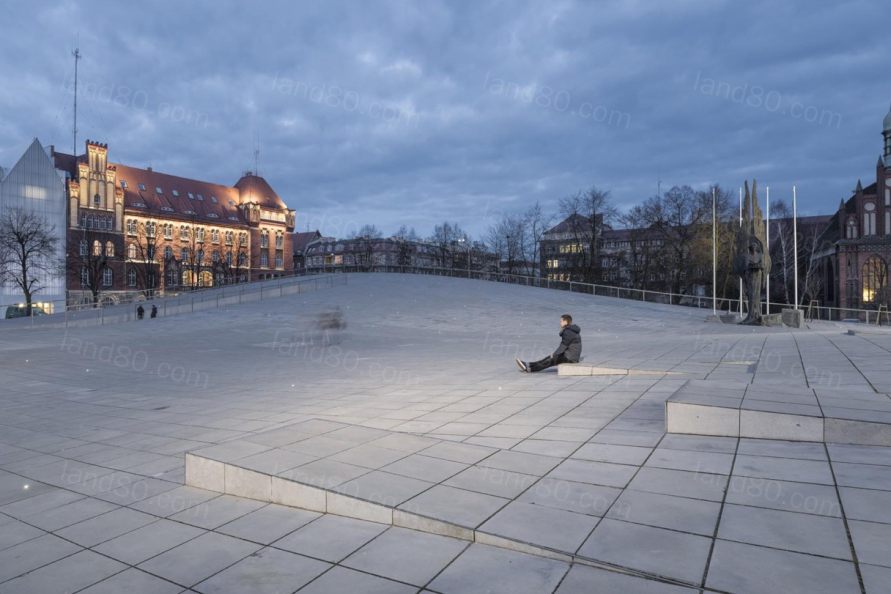历史和空间的背景
Szczecin市在波兰历史饱受战争摧残,直到1945年,这座城市一直属于德国领土,1945年之后被波兰占领。人口的大量流失瓦解了社会结构,扭曲了城市身份。在战争之前,Solidarności广场是城市的名片,有四分之一面积建成高档公寓,广场北方还有一个音乐厅。但在盟军的轰炸中,这个地区被夷为平地,于是从那时候开始,城市的名片不复存在。这个被夷为平地的“广场”在1970年成为工人抗议的场所,但随之被残酷镇压,16名抗议者被当场杀害,从那一刻起,场地就成了争取自由的象征。多年来,Solidarności广场只是一个有模糊边界的正方形场地,并没有加以建设来纪念1970年12月发生的事件,只是在2005年于场地的中央建造了一个纪念碑。21世纪后,这个广场开始被国家重视:2014年,由Estudio Barozzi Veiga设计的新音乐厅取代了原来被炸平音乐厅,该建筑成为新的城市标志,赢得了2015年密斯凡德罗奖。于是市政府计划,继续在场地上加盖一个国家博物馆的对话中心“Przełomy”,以纪念Szczecin市的苦难史。在设计博物馆的时候,我们把关注点放在了历史以及附近新城市建设的概念上,于是经过慎重考虑,我们的设计将博物馆隐藏在地下。
HISTORICAL AND SPACIAL CONTEXT
Szczecin is one of the largest victims of historical violence in Poland. Until 1945, the city lay within the borders of Germany, after which it was suddenly incorporated into Poland. Instant exchange of its population deconstructed the social fabric and distorted the city’s identity. Before the war, the current Solidarności Square was the showcase of the city, featuring a quarter of representative tenements, enclosed by the Konzerthaus in the North. During bombing raids of the Allied forces the quarter and its vicinity ceased to exist, creating a gap in the urban tissue. Furthermore, this fragment of the city was cut through by a transportation route. This quasi-square became the arena for worker protest in 1970, which was brutally pacified, and 16 protesters were killed. From that moment on, this place became a symbol of fight for freedom. For years, the Solidarności Square had been a square by name only – with vague borders, open frontages, burdensome busy street neighborhood and the absence of a defined function, despite the dominating one – to commemorate the events of December 1970, where the place was provided a monument in 2005. In the 21st century, the area became the arena of significant architectural interventions. In 2014, the former Konzerthaus was replaced by a new philharmonic venue designed by Estudio Barozzi Veiga. The building became the new city icon, winning the main Mies van der Rohe award in 2015. The next initiative, which contributed to changing the perception of the space was the National Museum's Dialogue Centre “Przełomy”, devoted to the history of Szczecin. When designing the Museum we set our mind humble to the history of the place and the new city icon closeby. Thus, the idea to hide the museum underground to create a background architecture.

概念:城市综合体
两个相互矛盾的传统:一个城市设计的混合,将空间围成四分之一,同时保留开放的公共空间的价值。广场的平坦区域在音乐厅和教堂前提供了前景,在相反的角落抬高地形,地下容纳了博物馆的设施;另一方面是一座人造山,屏蔽了周围的环境,使其免受繁忙街道的喧嚣。
IDEA – URBAN HYBRID
Two contradictory traditions: of a quarter and of a square were the point of departure for the design, an urban design hybrid which encloses the space as a quarter, while retaining the values of open public space. The flattened areas of the square create foregrounds in front of the philharmonic and the church. The quarter forms in oposite corners as elevated square floor. The one elevation houses the museum facillity, the other one is an artificial hill, closing up the urban interior and shielding it from the tumult of the busy street. There is no definite boundary between architecture and ubanism.




建筑物——结构和机械(活动墙)
建筑遵循地形,因此博物馆的形式是广场混凝土地板的延续。广场上覆盖着矩形瓷砖,在上升的地块中,这些铺装从平面空间提升到三维空间,成为立方块。当博物馆开放时,整个建筑就变成了一个整体,一些垂直的板块将旋转,将人吸引至两个入口底层是一个广场的延伸,它就像一个入口大厅。
BUILDING – STRUCTURE AND MECHANISMS (MOVABLE WALLS)
The architecture follows topography, hence the museum's form is a continuation of the concrete floor of the square which is covered with rectangular tiles. In the elevated corner these tiles gain 3rd dimension, becoming cuboidal blocks. The whole makes a monolith that transforms when the museum opens. Some of the vertical plates rotate, thus creating the arcades unveiling two entrances. The third entrance is determined by a ramp carved in the square's curvature. Ground floor is a square's extension and it functions as an entrance hall.


展览-用艺术讲述历史
展览空间隐藏在地下。当我们走下楼梯,混凝土结束,我们淹没在黑暗中,这是二战以Szczecin市的饱受摧残历史的一种表达,与波兰和世界其他地方发生的事情有关。在历史性展览的同时,我们在普通游玩的基础上,增加了一个以艺术家的杰作为主题的叙述——既有博物馆开馆前很久的作品,也有为这个展览场所特意创作的作品,这种尝试使展览变得更加广泛和普遍。黑暗的空间让人可以专注于呈现的物体,同时给人一种无限空间的印象,这个全新的展览模式使历史博物馆也成为艺术博物馆。
EXHIBITION – HISTORY TOLD WITH ART
The exhibition space is hidden underground. When we go down the stairs the concrete ends and we submerge in blackness that is a background for the tale of Szczecin since the II world war, in a connection of what was happening in Poland and the rest of the world. Simultaneously with the historic exhibition, based on pure information, we add a narration spinned by artists' masterpieces – both, the works from long before the museum was opened, and the ones intentionally created for this venue. This kind of attempt allowed the exhibition to become wider and more universal. The blackness allows to focus on presented objects while giving the impression of an infinite space. This brand new formula for the exhibition makes a historical museum an art museum as well.

广场-鼓励社会互动的地形
以前,广场只是为了纪念这段历史,由于重新开发,广场居民极其游客变得更加有吸引力,它的开放对于当地居民来说意义十分重大。人造山丘提供了一个发现城市新景观的机会,徒步旅行与日光浴都能在此进行,倾斜的地板启发了各种各样的活动:对于滑板运动员来说,这里是练习的理想场所,在冬天,广场也充当雪橇的轨道。广场保留了它的象征意义,纪念碑在每年的庆典活动中仍然吸引着退伍军人来自致敬。项目建成后,这个广场是一个友好和谐的公共空间,不同年龄和社会群体在此和谐相处。
SQUARE – TOPOGRAPHY ENCOURAGING SOCIAL INTERACTIONS
Before, the square was only to commemorate the history – as a result of redevelopment this part of the city became attractive for the other (remaining) habitants. Yet, its open formula encourages its users to express their impact. Artificial hills provide an opportunity for discovering new outlooks on the city, welcome walking tours and invite to sunbathing. The slanted floor inspires various activities: for skateboarders, this is the ideal spot to practice. In the winter, the square serves as a sled track. The yard has retained its symbolic dimension – the monument is still attracting veterans during annual celebration events – it is not dominating aspect after all. Today, this urban space is a place of amicable coexistance of different age and societal groups.



▼项目生成

▼顶视平面图

▼入口层平面图

▼剖面图

设计单位:KWK Promes, architects Robert Konieczny, Michał Lisiński, Dorota Żurek, Katarzyna Furgalińska
合作:architects Aleksandra Stolecka, Piotr Tokarski, Adam Radzimski, Joanna Biedna, Magdalena Adamczak
总承包商:Skanska
投资方:National Museum in Szczecin (Muzeum Narodowe w Szczecinie)
场地面积:9577平方米
总占地面积:1628平方米
使用面积:2117平方米
展览面积:960平方米
容积:15845 m3
竞赛:2009项目:2010-2011
建设时间:2012年1月-2月20日
NATIONAL MUSEUM IN SZCZECIN – DIALOGUE CENTRE PRZEŁOMY
Authors: KWK Promes, architects Robert Konieczny, Michał Lisiński, Dorota Żurek, Katarzyna Furgalińska
Collaboration: architects Aleksandra Stolecka, Piotr Tokarski, Adam Radzimski, Joanna Biedna, Magdalena Adamczak
General contractor: Skanska
Investor: National Museum in Szczecin (Muzeum Narodowe w Szczecinie)
Site area: 9577 m2
Gross covered area: 1628 m2
Usable floor area: 2117 m2
Exhibition surface: 960 m2
Volume: 15 845 m3
Competition: 2009 Project: 2010-2011
Construction: Jan 2012- Feb 2016
|